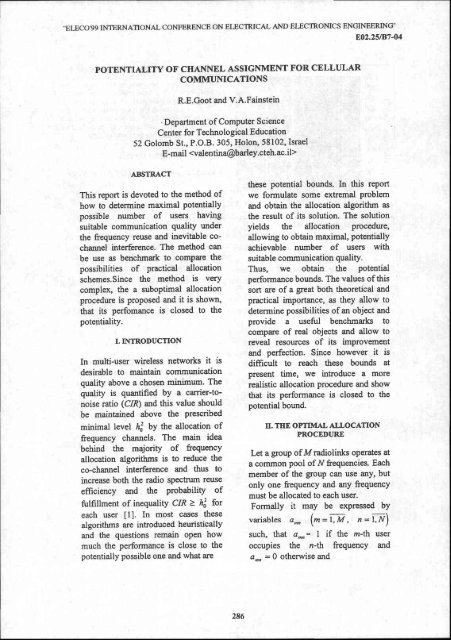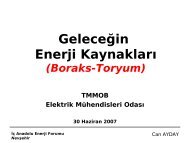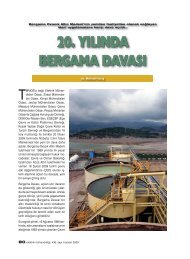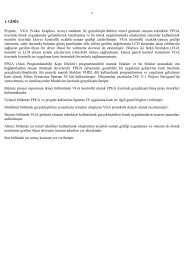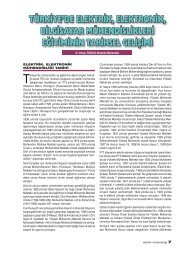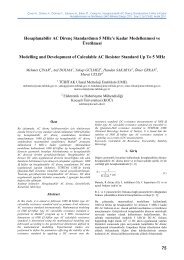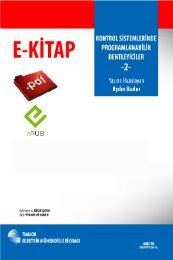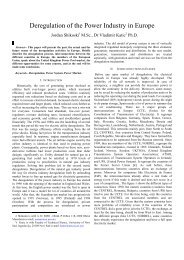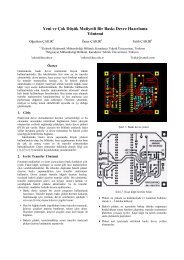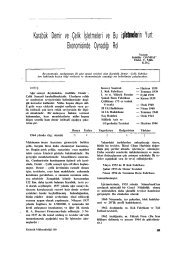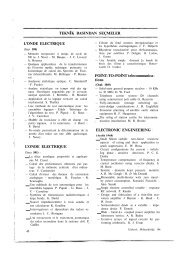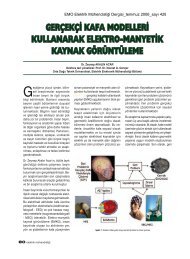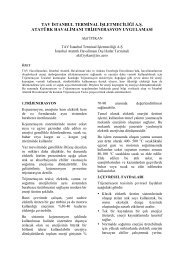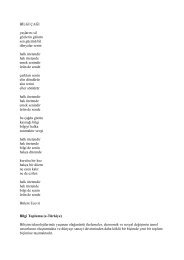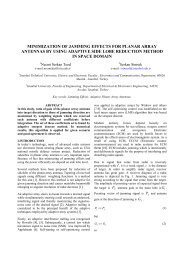POTENTIALITY OF CHANNEL ASSIGNMENT FOR ... - emo
POTENTIALITY OF CHANNEL ASSIGNMENT FOR ... - emo
POTENTIALITY OF CHANNEL ASSIGNMENT FOR ... - emo
Create successful ePaper yourself
Turn your PDF publications into a flip-book with our unique Google optimized e-Paper software.
.'ELECO'99 INTERNATIONALCONFERENCE ON ELECTRICAL AND ELECTR.ONICS ENGINEERING"<br />
F,02.25187-04<br />
<strong>POTENTIALITY</strong> <strong>OF</strong> <strong>CHANNEL</strong> <strong>ASSIGNMENT</strong> <strong>FOR</strong> CELLULAR<br />
COMMUNICATIONS<br />
R.E.Goot and V.A.Fainstein<br />
'Department of ComPuter Science<br />
Center for Technological Education<br />
52 Golomb St., P.O.B. 305, Holon, 58l02,Israel<br />
''ELECO'99<br />
INTERNATIONAL CONFERENCE<br />
ON ELECTRICAL AND ELECTR.ONICS<br />
ENGINEERING"<br />
to^, =r, ^=1,M. (l)<br />
The presented model is adequate to<br />
frequency reuse in cellular<br />
communication systems []. The C/R<br />
value for rz-th user under the condition<br />
that it occupies the z-th frequency is<br />
(n) O<br />
CIR(mV)=- P;;u'<br />
, (2)<br />
Loup(tQr * 1^<br />
k=l<br />
ktn<br />
where pP is the power transient<br />
coefficient from /+h user's transmitter<br />
to the rn-th user's receiver at the n-th<br />
frequency, Q, is the power of /-th<br />
transmitter, P^ is the power of<br />
environment noise for the m-th user<br />
receiver at the n-th frequency. The<br />
presence of variables tno in the<br />
denominator shows what &-th user<br />
transmits (or not) at the same n-th<br />
frequency and consequently, interferes<br />
with the rz-th one.<br />
The value showing suitability of the<br />
quality for the rz-th user under the<br />
given z is q(n4n)=ulcn(nln)-n:l<br />
with z(.r) is unit step function. Since<br />
a* arrd q(4")are equal to I or 0, the<br />
expression for number of users with<br />
suitable communication quality can be<br />
written as follows:<br />
MN<br />
s =2Zo^q(4,) =<br />
m=l n=l<br />
MN<br />
LLa*u<br />
n=l n=l<br />
[an(,,|")<br />
-h:)<br />
(3)<br />
The natural objective is to ma:cimize<br />
the value ,S and thus the procedure of<br />
optimal allocation consists in solution<br />
of the extremal problem<br />
S + max = S* under the conditions<br />
(l). The result of the solution will be a<br />
vector, =<br />
lo,-,f , supplying maximum<br />
to ^S and yielding the allocation<br />
algorithm. The probability that one<br />
user obtains the suitable<br />
communication quality is<br />
\ = E(S^*)f M with E(o) be the<br />
symbol of mathematical expectation,<br />
and we will accept this value as the'<br />
figure-of-merit for performance of the<br />
allocation procedure.<br />
Performance: We treated the<br />
performances for the case of<br />
homogeneity, that is, for all m, n,<br />
Q,, = Q, p and Fin, tro average values<br />
of fr!,ll and rrfl correspondingly<br />
(k *<br />
m), 1,=P , i/i,^,=d,<br />
andH=iQlP.The values d ail, H<br />
are the average signal-to-interference<br />
(^SIR) and signal-to-noise (,SIVR) ratios<br />
for one user. The obtained algorithm is<br />
generated by the extremal problem,<br />
belonging to .l/P-complete ones with<br />
essential difficulties for the solution.<br />
Owing to .l/P-completeness and since<br />
our aim does not consist in<br />
surmounting of computation<br />
difficulties, we restricted ourselves to<br />
simple exploration example solved by<br />
simulation. The simulation was<br />
performed for the case of log-normal<br />
shadowing (slow) fading, averaged<br />
over fast fading [2]. The results of the<br />
simulation are presented in Fig l.<br />
III. TEE SUBOPTIMAL ALLOCATION<br />
PROCEDTJRE<br />
Since the optimal procedure is .l/Pcomplete<br />
and hardly feasible<br />
practically we introduce the following<br />
heuristical allocation procedure<br />
a= {a^: a,^ = l,a^r = o for n such<br />
that pf) > pl* ;",k . {t,"}, k * n}' ,<br />
(4)<br />
According to the procedure each user<br />
occupies its best frequency regardless<br />
of pretensions and intentions of other
..ELECO'99 INTERNATIONAL CONFERENCE ON ELECTRICAL AND ELECTRONICS ENGINEERING"<br />
users.As for characterization of<br />
performance here unlike the optimal<br />
procedure, we can obtain the<br />
expression for P, analytically.<br />
Let all random variables fri,} *a f-.lj?<br />
are statistically independent with the<br />
s.rme density function (for<br />
"fr$)<br />
variables plil,m=lJl,M,, = f,-/r)-d<br />
-fr^!t)( for variablespfl, k =\fr,<br />
k*n)<br />
t<br />
Denoterl = nraxPr$, 9, =<br />
I<br />
Po,<br />
t=l<br />
where random variables<br />
F, (l =l,M -l) posses the same<br />
density{", (p).<br />
Then the CIR value for n-th user under<br />
the condition, that I other users also<br />
chose the same frequency is<br />
'\Q<br />
clRil\=<br />
9,Q+P<br />
Now we can write<br />
=-rl-<br />
$,+PlQ<br />
(5)<br />
M-l<br />
n = }ptDrr{crn14 , t':1, (6)<br />
t4<br />
where P(l) is the probability<br />
that / other usent chose the same<br />
frequency,<br />
t-<br />
P(l)==r Q=l,M-l),<br />
N'<br />
M-l<br />
P(0)=1-IP(|)=<br />
t=l<br />
, Nu-t -r<br />
, -<br />
ilr11/_ l)<br />
(7)<br />
The density function of variable 11 is<br />
equal [3 1 ,rr(n) =.MFu"-'(n),f,(n).<br />
With use of the density functions and<br />
formula (6) we obtain<br />
o ?<br />
P"=P(o) lf,filan+<br />
ti p/O<br />
288<br />
t rurT t"1s)ds i .rno>a, =<br />
/=l o ro2 (s ,- plQ)<br />
(<br />
['-<br />
NM-'<br />
( N-l)<br />
N<br />
I#[^''n '<br />
'-i('- (N- l) l/<br />
I<br />
-l<br />
)r<br />
r- F! (htPlq)+<br />
[r-ri taf ts + P/Q)]lds =<br />
NM-I I M.<br />
,)<br />
(8)<br />
Fi (hiPla)+<br />
E#i t,rsr{(r,,i(s . Ptqls<br />
I<br />
where<br />
"fr,(9)<br />
variable 9, .<br />
is density function of<br />
Note that the term in the braces gives<br />
the expression for probability of<br />
outage (quality of communication is<br />
unsiutable). The computational<br />
example was performed for the<br />
condition of the previous case with<br />
usage of approximation of density<br />
/s, (9) by log- normal one [4].<br />
The results are presented<br />
in Eig.2<br />
IV. CONCLUSION<br />
l. The obtained potential performance<br />
bounds d<strong>emo</strong>hstrate the strong<br />
dependence on co-channel interference<br />
in the case of number of users M is<br />
more than the number of frequencies<br />
N. If .l/ : M the users prefer to work at<br />
different frequencies and the<br />
possibility to work also at the same<br />
frequency for several users does not<br />
improve the performance, essentially<br />
even if the value,Fl is not so great.<br />
2.The suboptimal procedure<br />
performance is closed to the results for<br />
optimal one, at least for the treated<br />
model and parameters. Note, that the<br />
prepared heuristic allocation procedure<br />
is of "local" character, unlike the
"ELECO'99 INTERNATIONAL CONFERENCE ON ELECTRICAL AND ELECTR.OMCS ENGINEERING'<br />
0 5 r0 15 d(dB)<br />
Fig.l- Probability of outage<br />
versus .9/R for.l/=3 (optimal<br />
allocatioru-tly':4,- - *I=3 ).<br />
optimal procedwe which must be<br />
centmlized. It means, that for<br />
suboptimal procedure each user<br />
chooses its channel irrespective of<br />
other users. Thus the procedwe are<br />
more realistic and easier implemented.<br />
3. The presented optimal procedure<br />
refers to class ofcentralized allocation<br />
schemes t5l and provides a useful<br />
benchmark to compare performance of<br />
real allocation schemes.<br />
REFERENCES<br />
tU L.Kau.ela and M.Naghshinen,<br />
"Channel Assignment Schemes for<br />
Cellular MobileTelecommunication<br />
Systems: A Comprehensive Suwey'',<br />
100<br />
l0-l<br />
l0-2<br />
,<br />
0Q<br />
\<br />
>-<br />
0 5 t0 15 d(dB)<br />
Fig.2. Probabiliry of outage<br />
versus .S/R fori/:3 (suboptimal<br />
allocation, M=4).<br />
IEEE Personal Commun., Iute,<br />
1996<br />
pp. 10-30,.<br />
[2] W.C.J Lee, Mobile Communication<br />
Engineering, McGraw Hill, 1982.<br />
[3] H.A.David, Order .Sratsa'cs, John<br />
Wiley & Sons Inc.,l970<br />
[4] N.C. Beaulicu, A.A- Abu-Day4<br />
P.J.M.Lanc,"Estimating the Distribution<br />
of a Sum of Independent<br />
Lognormal Random Yariables-, IFEE<br />
Transaction on Communications, v.43,<br />
No. I 2, I 995, pp. 2869-2873<br />
[5] G.L.Stuber, Principles of Mobile<br />
Communication, KJuwer Acad. publ.,<br />
1996.


